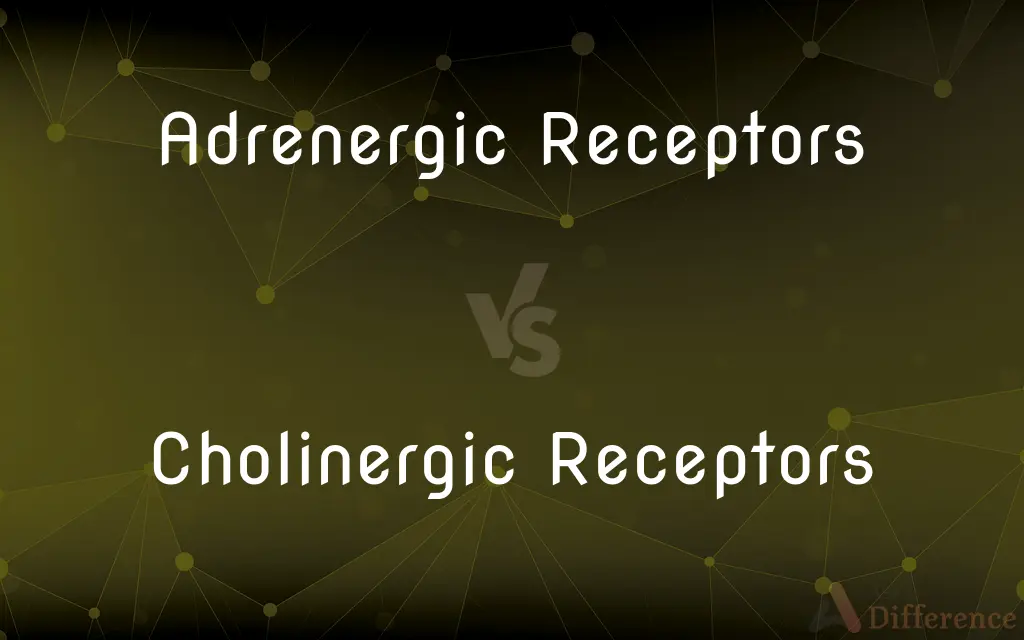Adrenergic Receptors vs. Cholinergic Receptors — What's the Difference?
By Urooj Arif & Maham Liaqat — Published on February 25, 2024
Adrenergic receptors respond to adrenaline, playing key roles in the fight-or-flight response, whereas cholinergic receptors respond to acetylcholine, crucial for activating muscles and various brain functions.

Difference Between Adrenergic Receptors and Cholinergic Receptors
Table of Contents
ADVERTISEMENT
Key Differences
Adrenergic receptors are activated by adrenaline (epinephrine) and noradrenaline (norepinephrine), neurotransmitters associated with the body's fight-or-flight response. They are primarily involved in increasing heart rate, dilating airways, and mobilizing energy. Cholinergic receptors, on the other hand, are activated by acetylcholine, a neurotransmitter vital for muscle activation, parasympathetic nervous system responses, and certain types of brain functions, including memory and alertness.
There are two main types of adrenergic receptors: alpha (α) and beta (β), each with subtypes that have different locations and functions, such as constricting blood vessels or relaxing smooth muscles. Cholinergic receptors are categorized into nicotinic and muscarinic types. Nicotinic receptors are primarily found in the neuromuscular junctions, facilitating muscle contraction, while muscarinic receptors are located in the heart, smooth muscles, and brain, influencing various parasympathetic nervous system activities.
Adrenergic receptors mediate their effects through interactions with G proteins, leading to various intracellular changes, such as the activation of adenylate cyclase or phospholipase C. This results in the alteration of cell function in response to external stress or danger. Cholinergic receptors also interact with G proteins (muscarinic) or act as ion channels (nicotinic), modulating cellular activities through different mechanisms, such as changing ion permeability or second messenger cascades.
The activation of adrenergic receptors generally prepares the body for physical activity by increasing blood flow to muscles, boosting heart rate, and breaking down fat. Cholinergic receptor activation, conversely, often supports rest-and-digest functions, such as slowing the heart rate, increasing digestive activity, and promoting gland secretion.
Both adrenergic and cholinergic receptors play critical roles in the autonomic nervous system, but they often have opposing effects on organ systems. For example, adrenergic activation might accelerate heart rate, whereas cholinergic activation tends to decrease it, maintaining the body's internal balance.
ADVERTISEMENT
Comparison Chart
Activating Neurotransmitter
Adrenaline (epinephrine) and Noradrenaline (norepinephrine)
Acetylcholine
Main Types
Alpha (α) and Beta (β)
Nicotinic and Muscarinic
Primary Location
Heart, blood vessels, lungs, and muscles
Heart, smooth muscles, brain, and neuromuscular junctions
Function
Regulate cardiovascular and respiratory systems, mobilize energy
Control muscle contraction, influence parasympathetic nervous system activities, support cognitive functions
Mechanism of Action
Generally via G protein-coupled processes, affecting intracellular signaling
Muscarinic receptors via G protein-coupled processes, nicotinic receptors as ion channels
Compare with Definitions
Adrenergic Receptors
Beta receptors increase heart rate
Beta-1 receptors in the heart are activated by adrenaline to increase heart rate.
Cholinergic Receptors
Muscarinic receptors slow heart rate.
Muscarinic receptors in the heart are activated by acetylcholine to reduce heart rate.
Adrenergic Receptors
Involved in pupil dilation.
Alpha-1 receptors in the eye mediate pupil dilation in low light.
Cholinergic Receptors
Control smooth muscle activity.
Muscarinic receptors in the intestines stimulate digestive movements.
Adrenergic Receptors
Alpha receptors constrict blood vessels
Alpha-1 receptors in blood vessels respond to adrenaline by causing vasoconstriction.
Cholinergic Receptors
Involved in gland secretion.
Muscarinic receptors in salivary glands stimulate saliva production.
Adrenergic Receptors
Adrenergic receptors influence metabolic processes.
Beta-2 receptors in fat cells help in the breakdown of fat.
Cholinergic Receptors
Affect brain functions.
Cholinergic receptors in the brain are involved in memory and learning processes.
Adrenergic Receptors
They regulate airway diameter.
Beta-2 receptors in the lungs dilate the airways during stress.
Cholinergic Receptors
Nicotinic receptors facilitate muscle contraction.
Nicotinic receptors at the neuromuscular junction activate muscle contraction.
Common Curiosities
Can both adrenergic and cholinergic receptors be found in the heart?
Yes, both types of receptors are present in the heart, but they have opposite effects; adrenergic receptors increase heart rate, while cholinergic receptors decrease it.
What are adrenergic receptors?
Adrenergic receptors are proteins on cell surfaces that respond to adrenaline and noradrenaline, involved in the body's fight-or-flight response.
What neurotransmitter activates cholinergic receptors?
Acetylcholine activates cholinergic receptors.
How do adrenergic and cholinergic receptors differ in function?
Adrenergic receptors primarily prepare the body for physical activity, whereas cholinergic receptors are involved in rest-and-digest functions and cognitive processes.
What role do nicotinic receptors play?
Nicotinic receptors facilitate muscle contraction by acting as ion channels at neuromuscular junctions.
How do muscarinic receptors affect the digestive system?
Muscarinic receptors stimulate digestive movements and gland secretions, aiding in digestion.
Are adrenergic receptors involved in energy mobilization?
Yes, adrenergic receptors, especially beta-2 receptors, are involved in breaking down fat to mobilize energy.
What is the main difference between alpha and beta adrenergic receptors?
Alpha receptors mainly cause vasoconstriction and pupil dilation, while beta receptors primarily affect heart rate, airway diameter, and metabolic processes.
What is the effect of adrenergic receptors on blood vessels?
They can cause blood vessels to constrict or dilate, depending on the subtype of receptor and its location.
What is the significance of cholinergic receptors in the brain?
They are crucial for memory, learning, and alertness by modulating the activity of neural circuits involved in these processes.
Why are adrenergic and cholinergic receptors important for the autonomic nervous system?
They are essential for maintaining homeostasis by mediating opposite effects in the sympathetic (adrenergic) and parasympathetic (cholinergic) branches of the autonomic nervous system.
Can cholinergic receptors influence heart rate?
Yes, muscarinic cholinergic receptors can decrease heart rate when activated.
What triggers the activation of cholinergic receptors in the digestive system?
The release of acetylcholine from parasympathetic nerves triggers their activation, promoting digestive activities.
Do adrenergic receptors have a role in respiratory function?
Yes, particularly beta-2 receptors, which dilate the airways and improve airflow during stress.
How do the mechanisms of action differ between adrenergic and cholinergic receptors?
Adrenergic receptors typically act through G protein-coupled processes, while cholinergic receptors can act through G protein-coupled processes (muscarinic) or as ion channels (nicotinic).
Share Your Discovery

Previous Comparison
Roofing vs. Ceiling
Next Comparison
Orange Juice with Pulp vs. Orange Juice without PulpAuthor Spotlight
Written by
Urooj ArifUrooj is a skilled content writer at Ask Difference, known for her exceptional ability to simplify complex topics into engaging and informative content. With a passion for research and a flair for clear, concise writing, she consistently delivers articles that resonate with our diverse audience.
Co-written by
Maham Liaqat















































